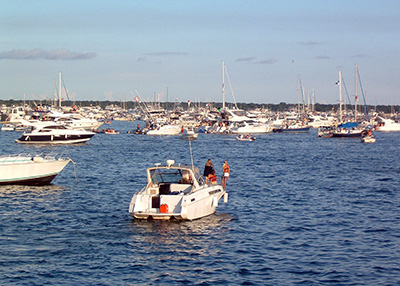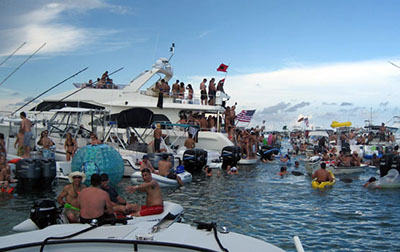
Safety at Columbus Day Regatta improving
HOMESTEAD, Fla. — In 1954, a group of sailors began a friendly race in Biscayne National Park to mark Columbus Day weekend, making their way down Biscayne Bay and then camping out for the night. It was an event free of spectators, free of outside attention, comprised mainly of locals who frequented the bay.
But before long recreational boaters caught wind of the race and began to gather at the finish line, turning it into a social affair. By 1984 the race grew to 761 registered sailors and even more outsiders who were there for the party more than the sporting. Since then, the Columbus Day Regatta has earned the nickname “Mardi Gras of Miami” and has become a high priority for local police, park rangers, and the Coast Guard.
 |
Boaters at the Columbus Day Regatta (Photo courtesy of Biscayne National Park). |
According to the National Park Service, the 2012 regatta saw more than 200 law enforcement cases, including boating under the influence arrests, drug seizures, and a helicopter evacuation. The NPS was thankful, claiming to have gotten away “relatively unscathed” from the weekend.
Gary Bremen, a park ranger at Biscayne National Park for the past 18 years, said that while the event is still dangerous, there has been much improvement from the peak of illegal activity in the 1980s. While boaters still gather inside the park, the actual race no longer takes place within its borders.
“This past year was much more controlled,” Bremen said. “We were out there Friday afternoon telling people the rules and we had a media conference with folks that had experienced deaths of family members at previous Columbus Day Regattas.”
One of the families was that of Juan Carlos Morales, who died after falling off the back of a 65-foot boat and landing on the propellers at the 2011 regatta. In response to this and other tragedies, Bremen said the park service has taken further steps in the past two years such as regulating noise levels during the weekend and limiting the number of boats that may be rafted together to five.
According to John Adornato, the Sun Coast Region director of the National Parks Conservation Association, there is still more that can be done to protect Biscayne National Park from some of the harmful impacts of the regatta.
“National parks are special and unique,” Adornato said. “You have a different set of rules and regulations than you do in a normal place.”
For Adornato, whose job is to advocate for the preservation of the national parks, a major problem he cites is that most people aren’t aware they’re entering a national park when they come to the event, seeing it simply as a party location.
With 95 percent of Biscayne National Park’s surface submerged in the ocean, one consistent criticism has been that it is difficult to access for people without a boat.
Terri Cantu is the owner of Yacht Charters in Miami, a boat charter company that has been affected by the elevated security of the recent regattas. According to Cantu, her company is no longer able to offer customers trips to the Columbus Day Regatta, something she sees as part of a disheartening trend for the park.
“Anyone visiting Miami deserves to have the same availability as someone with a boat,” Cantu said. “The event is fun and should be an open opportunity.”
Cantu points to other public gatherings such as NASCAR races that have faced their own accidents and controversies in recent years, suggesting that recoil against boaters has placed the blame unfairly.
“I think their goal is to diminish all activity at the sandbar for safety reasons, but anytime you have a big group of people together you’ll have safety issues,” said Cantu.
Another charter specialist, Carolina Rojas of Golden Yacht Charters, said she agrees the authorities have limited her ability to take people to the event. She said her company has even faced legal pressure to stop advertising their services online using the phrase “Columbus Day Regatta.”
“Because of the accidents and regulations and park rangers, the Columbus Day Regatta is not what it used to be,” Rojas said. “The city just doesn’t want it and the park doesn’t want people there.”
| Boaters gathered at the 2012 Columbus Day Regatta in Biscayne Bay (Photo courtesy of Biscayne National Park). |  |
Caki Padron, a 22-year-old student at the University of Miami and Miami native, has been attending the Columbus Day Regatta for six years. As a boat owner, he said he has always been aware of the national park’s location but doesn’t believe that should limit his ability to take part in the social aspect of the weekend.
“I have other friends with boats and we all like to tie up together and just hang out for the day,” Padron says. “The people who go to the park know what they’re getting themselves into.”
Maritime law enforcement specialist Charles Kinnear has been working at the regatta since 2009 on behalf of the United States Coast Guard. Their patrol schedule is elevated over the weekend to include 24-hour coverage of the bay. He said he expects the trend of decreased illicit activity during Columbus Day Weekend to continue for the foreseeable future, as the Coast Guard takes steps such as printing out brochures two months in advance of the regatta to educate the public.
“If something happens and I know about it, I’m going to do something,” Kinnear said. “Just because it’s a park doesn’t mean we’re going to be less aware of the situation. Safety is our number one concern.”
The National Park Service got creative last year on its Biscayne National Park Facebook page, sharing with its more than 2,000 fans an image of rowdy boaters at a previous regatta cut and pasted into a background of pine trees and mountains with caption “Would this happen at Yosemite National Park?” While some users who called out the obvious use of Photoshop missed the sarcastic nature of the post, it managed to draw more shares than the vast majority of the page’s content, proving that the park service was at least able to start a conversation.
Bremen said he has similar visions about the future of the Columbus Day Regatta, calling the 2012 weekend a step in the right direction. With a key addition to the Biscayne National Park staff, Bremen believes things might stay this way. Incoming superintendent Brian Carlstrom comes from the Chesapeake and Ohio Canal in Maryland and brings with him more than 20 years of experience with the National Park Service.
“Our new superintendent comes in next week with a background in resource management,” Bremen said. “We have high hopes for him to continue the trend of pulling the reigns in.”
In an event mired by six deaths in the past 10 years, for Bremen the mere fact that everyone survived the most recent one is cause for celebration.

Comments are Closed